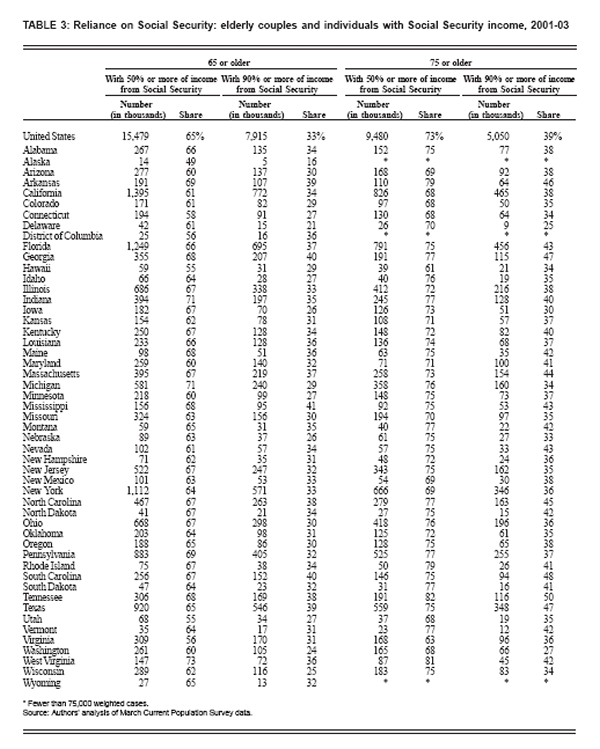Issue Brief #206
Social Security and the income of the elderly
By Michael Ettlinger and Jeff Chapman
Under current law, the Social Security program ensures that Americans can maintain a basic quality of life if they, or a worker they rely on, lose the ability to work due to age, disability, or death. Workers who become disabled or reach retirement receive a Social Security income based on how long they have worked and how much they have earned. Spouses and children of deceased, disabled, and retired workers also receive Social Security.
Although Social Security is an important insurance program for people of all ages, at any given point in time the largest single demographic group of recipients is those age 65 and over. For a large majority of this group, the program is critical to their quality of life65% of these elderly rely on Social Security for over half their income (see Figure 1 and Figure 2). That’s a total of over 15 million individuals and couples. One-third (33%) rely on Social Security for over 90% of their income. Nationally, the median married couple or individual recipient age 65 and over relies on Social Security for 67% of income. High reliance on Social Security for the well-being of the elderly is typical regardless of sex, race, or state of residence (shown in Table 1 and Table 2).


The findings are even more pronounced for the elderly age 75 and over. This is not surprising, as these older workers are less able to work than the younger elderly and are more likely to have spent down some of their personal savings. Almost three-quarters (73%) of those age 75 and over who receive Social Security payments rely on Social Security for over half their income.


These data suggest that, for most retirees, cuts in benefits would have a very large effect on living standards. With the rate of savings at historically low levels, there is reason to believe that coming generations of retirees will not be in any better position. Replacing the current system’s prescribed benefit levels with a system in which income is more reliant on the varying market returns from private investment vehicles would hurt those retirees who do not happen upon the best-performing investments.
There is some variation in these data by state, but in all states the elderly rely very heavily on their Social Security, and the elderly in all but one state count on Social Security benefits for over half their income (see Table 2 and Table 3). The lowest level of reliance is in Alaska, where, at the median, the elderly rely on Social Security for 49% of their income. The highest level of reliance is in Arkansas, at 77%.

Replacing the Social Security system would fundamentally change the experience of retirement in the United States. In particular, making what has been a secure source of income subject, to a significant degree, to the inconsistent performance of market investments instead of lifetime work history would have a substantial effect on retirees. There is good reason to believe that privatization would worsen the financial future of Social Security and result in an overall net decrease in income for seniors. But leaving those issues aside, it is undisputed that privatization would introduce a greater variation among retirees in the income available for their retirement.
By showing how very reliant the elderly are on Social Security income, these data demonstrate that the majority of the elderly can ill-afford to gamble with their retirement income now or in the future. Ending up on the losing side of this bet would have a devastating impact on their quality of life.
Methodology
The source for these data is the March Current Population Survey from the U.S. Census Bureau. The methodology mimics that of the Social Security Administration’s Income of the Population 55 or Older, 2000. Following that publication, the primary unit of interest is the “aged unit,” which is either a person who is 65 or older and not married or a married couple living togetherone of whom is 65 or older. Aged unit total income and Social Security income are the income coming from the aged unit, disregarding the income of other family members. Total money income includes wages and salaries, self-employment income (including losses), Social Security, Supplemental Security Income, public assistance, interest, dividends, rent, royalties, estates or trusts, veterans’ payments, unemployment compensation, workers’ compensation, private and government retirement and disability pensions, alimony, and child support. Race of married couple aged units is based on the race of the husband, following the SSA practice.